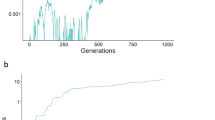Abstract
Selection for fast and slow remating was carried out, with selection being based on the behavior of one sex. None of the male selection lines produced a significant response to selection, in lines selected either on the basis of the first male to mate with a female or on the basis of the second male to mate with a female. In contrast, three of four female selection lines showed significant responses to selection. Males in the female selection lines were tested for changes in their mating speed when paired with unselected females. These tests suggest that genes affecting remating speed in females are largely sex limited in their action. The gender difference in response to selection is discussed in terms of sexual selection theory.
Similar content being viewed by others
References
Bateman, A. J. (1948), Intra-sexual selection inDrosophila.Heredity 2:349–369.
Falconer, D. S. (1981).Introduction to Quantitative Genetics, Longman, London.
Fukui, H. H., and Gromko, M. H. (1988). Female receptivity to remating and early fecundity inDrosophila melanogaster (in preparation).
Gilbert, D. G., Richmond, R. C., and Sheehan, K. B., (1981). Studies of esterase 6 inDrosophila melanogaster. VII. The timing of remating in females inseminated by males having active or null alleles.Behav. Genet. 11:195–208.
Gromko, M. H., and Jensen, M. (1983). The effects of culture medium on productivity.Dros. Info. Serv. 59:46–47.
Gromko, M. H., Newport, M. E. A., and Kortier, M. G. (1984). Sperm dependence of female receptivity to remating inDrosophila melanogaster.Evolution 38:1273–1282.
Letsinger, J. T., and Gromko, M. H. (1985). The role of sperm numbers in sperm competition and female remating inDrosophila melanogaster.Genetica 66:195–202.
Newport, M. E. A., and Gromko, M. H. (1984). The effect of experimental design on female receptivity to remating and its impact on reproductive success inDrosophila melanogaster.Evolution 38:1261–1272.
Parker, G. A. (1970). Sperm competition and its evolutionary consequences in the insects.Biol. Rev. 45:525–567.
Parker, G. A. (1979): Sexual selection and sexual conflict. In Blum, M. S., and Blum, N. A. (eds.),Sexual Selection and Reproductive Competition in Insects, Academic Press, New York.
Parker, G. A. (1983). Arms races in evolution—An ESS to the opponent-independent costs game.J. Theor. Biol. 101:619–684.
Parker, G. A. (1984). Sperm competition and the evolution of animal mating strategies. In Smith, R. L. (ed.),Sperm Competition and the Evolution of Animal Mating Systems, Academic Press, New York, pp. 1–60.
Pyle, D. W., and Gromko, M. H. (1981): Genetic basis for remating inDrosophila melanogaster.Am. Nat. 117:133–146.
Author information
Authors and Affiliations
Additional information
This work was supported by NSF Grants BNS 82-01183 and BNS 84-18934
Rights and permissions
About this article
Cite this article
Gromko, M.H., Newport, M.E.A. Genetic basis for remating inDrosophila melanogaster. II. Response to selection based on the behavior of one sex. Behav Genet 18, 621–632 (1988). https://doi.org/10.1007/BF01082313
Received:
Accepted:
Issue Date:
DOI: https://doi.org/10.1007/BF01082313




